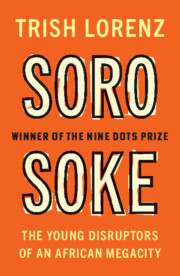Book contents
- Soro Soke
- Soro Soke
- Copyright page
- Contents
- Figures and Illustrations
- About the Nine Dots Prize
- 1 The Soro Soke Generation
- 2 The New York of Nigeria
- Speaking Out: Chekwube Okonkwo on Expressing African Identity
- 3 Cultural Capital
- Speaking Out: Osinachi on Art and Nigerian Identity
- Speaking Out: Priscilla Eke on Feminism
- 4 Challenging Norms
- Speaking Out: Uyaiedu Ipke-Etim on Facing Homophobia
- Speaking Out: Michael Elégbèdé on the Diaspora
- 5 Japá
- Speaking Out: Davies Okeowo on Entrepreneurship
- 6 Entrepreneurs with a Mission
- 7 The New Oil
- Speaking Out: Rinu Oduala on the #endSARS Protests
- 8 The Hashtag Generation
- Speaking Out: Princess Obiajulu Ugwu on Standing for Election
- Speaking Out: Fortunes Oronkwo on the Monetisation of Politics
- 9 Contesting for Power
- 10 We’re in This Together
- Acknowledgements
- Notes
2 - The New York of Nigeria
Published online by Cambridge University Press: 23 May 2022
- Soro Soke
- Soro Soke
- Copyright page
- Contents
- Figures and Illustrations
- About the Nine Dots Prize
- 1 The Soro Soke Generation
- 2 The New York of Nigeria
- Speaking Out: Chekwube Okonkwo on Expressing African Identity
- 3 Cultural Capital
- Speaking Out: Osinachi on Art and Nigerian Identity
- Speaking Out: Priscilla Eke on Feminism
- 4 Challenging Norms
- Speaking Out: Uyaiedu Ipke-Etim on Facing Homophobia
- Speaking Out: Michael Elégbèdé on the Diaspora
- 5 Japá
- Speaking Out: Davies Okeowo on Entrepreneurship
- 6 Entrepreneurs with a Mission
- 7 The New Oil
- Speaking Out: Rinu Oduala on the #endSARS Protests
- 8 The Hashtag Generation
- Speaking Out: Princess Obiajulu Ugwu on Standing for Election
- Speaking Out: Fortunes Oronkwo on the Monetisation of Politics
- 9 Contesting for Power
- 10 We’re in This Together
- Acknowledgements
- Notes
Summary
The pace of urbanisation across sub-Saharan Africa over the last 60 years is without precedence. In 1950, most African countries were agrarian societies and just over a quarter of the population lived in cities. By 2020, the continent had 74 cities with a population of more than one million people, equivalent to the US and Europe combined. Today almost half of sub-Saharan Africans are urban dwellers and by 2050 that number is projected to reach 60 per cent. That means two- thirds of the continent’s projected population growth over the next three decades – an additional 950 million people – will be absorbed by the region’s humming, thriving, bustling megacities. And, as the OECD notes, ‘this transition is profoundly transforming the social, economic and political geography of the continent.’ Lagos, with a population of more than 20 million and economy bigger than that of Kenya is a vast, energetic and flourishing metropolis, a centre of opportunity that is enabling young Nigerians to be wealthier, more open-minded and more cosmopolitan than any before it.
Keywords
- Type
- Chapter
- Information
- Soro SokeThe Young Disruptors of an African Megacity, pp. 16 - 30Publisher: Cambridge University PressPrint publication year: 2022
- Creative Commons
- This content is Open Access and distributed under the terms of the Creative Commons Attribution licence CC-BY-NC-ND 4.0 https://creativecommons.org/cclicenses/

